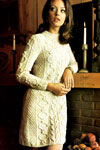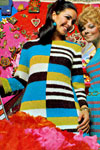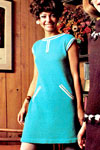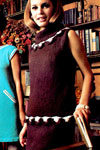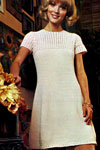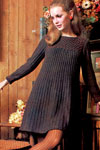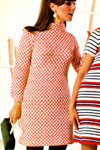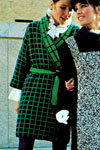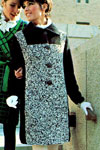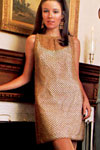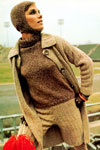Newly Added Knit Patterns
The Knit Scene | Book 768 | Columbia Minerva
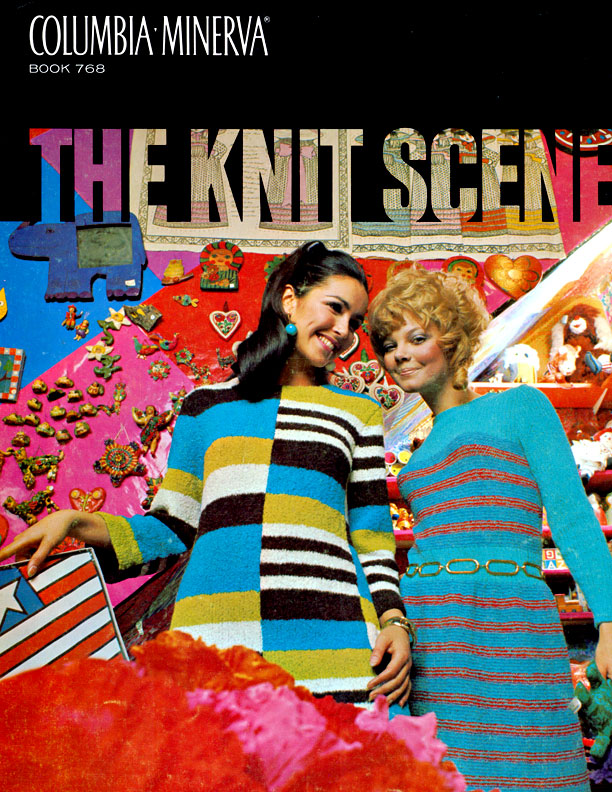
The Knit Scene
Book 768
Columbia Minerva
Original Copyright 1968
INSTRUCTIONS ARE BASED ON THE
FOLLOWING BODY MEASUREMENTS |
||||||||
Sizes |
8 |
10 |
12 |
14 |
16 |
18 |
20 |
|
Bust |
31½ |
32½ |
34 |
36 |
38 |
40 |
42 |
inches |
Waist |
23 |
24 |
25½ |
27 |
29 |
31 |
34 |
inches |
Hips |
33½ |
34½ |
36 |
38 |
40 |
42 |
44 |
inches |
GENERAL INSTRUCTIONS
The garments in this book have been made with Columbia-Minerva Yarn — your guarantee of prime quality. To insure successful results, we stress the importance of using the yarns recommended in the instructions, carefully checking the gauge as described below.
Gauge:
Each Columbia-Minerva instruction indicates a gauge or scale of the number of stitches to the inch, when using the yarn and the size of needles recommended. If you work tighter than average, change to larger needles; if you work looser, change to smaller needles to achieve the same number of stitches to the inch indicated in the instructions.
Blocking:
Use brass pins which are rust-proof. Pin each piece, wrong side up, on a padded surface in exactly the line you wish to retain.
Use a damp cloth and a moderately hot iron, pressing very lightly — do not allow weight of iron to rest on garment.
Do not remove garment until thoroughly dry.
Remove pins and steam out pin marks.
Assembling:
Sew pieces together, being careful that the edges meet evenly and to match rows wherever possible. Steam all seams on wrong side.
WASHING INSTRUCTIONS FOR WOOL YARNS:
Wash by hand using mild soap flakes, cold water soap or mild detergent. Squeeze suds through fabric but do not rub. Mild, alkali-free soap flakes may be used, but it is most important that the soap be thoroughly dissolved before immersing the garments and water must be tested for tepid, lukewarm temperature before use. Knits should not be allowed to soak for more than a very few minutes.
To Rinse:
Rinse thoroughly. If soap flakes are used, be sure that no soap remains in the garment. Always support garment with your hands when lifting it out of the water, as the added weight of the water tends to stretch the fabric. Never wring or twist, always squeeze out excess moisture gently.
To Dry:
Roll garment in a thick terry towel to remove excess moisture. Pat garment into original size and shape. Dry on a flat surface away from heat and sunlight which affects white and pastel shades.
Important:
A few drops of white vinegar added to the final rinse "sets" the color and prevents bleeding of one color onto another.
This is especially important when white is knit with contrasting colors.
Use method most convenient for you. Turn garment inside out.
Machine Washing:
Set at any convenient temperature and cycle using a suitable soap or detergent. A fabric softener is recommended in final rinse.
Do not use bleach.
Or, Hand Wash in cold or warm water with suitable soap or detergent. Rinse well and roll in towel to remove excess water.
Machine Drying:
Set at any convenient temperature and cycle.
To Hand Dry, lay garment flat, mould into shape. Be sure garment is thoroughly dry before wearing.
Never hang or stretch a handknit. Do not dry in sun.
| Pattern Categories Browse the categories to help you find the patterns you're looking for. |
||
|
||













